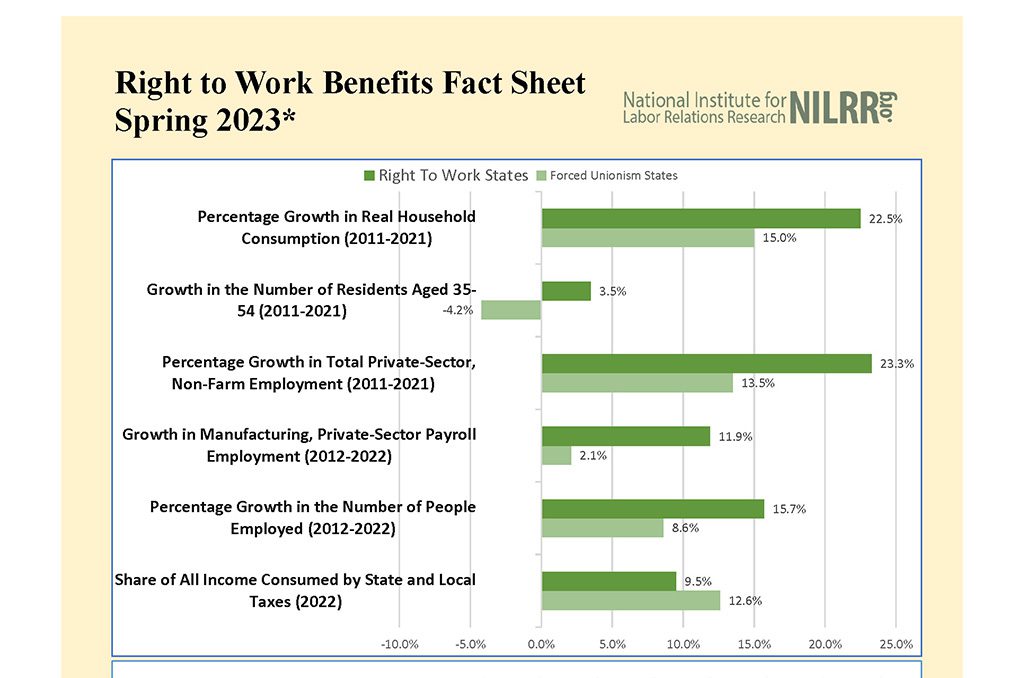Right To Work Benefits 2023

- Right To Work States have enjoyed a manufacturing payroll employment increase more than 5X greater than that of Forced Unionism States
- The Per Capita Disposable Income in Right To Work States is 5% greater than in Non-Right To Work States.
- More younger working Americans (Aged 35-54) are moving into Right To Work States, while more are fleeing Compulsory Unionism States
Download PDF file of the Right To Work Benefits 2023 Fact Sheet.
Percentage Growth in the Number of People Employed (2012-2022)
Source: Dept. of Labor, Bureau of Labor Statistics (BLS) Household Survey
Right To Work States
15.75%
Forced Unionism States
8.6%
Growth in Manufacturing, Private-Sector Payroll Employment (2012-2022)
Source: BLS Establishment Survey
Right To Work States
11.9%
Forced Unionism States
2.1%
Percentage Growth in Total Private-Sector, Non-Farm Employment (2011-2021)
Source: Dept. of Commerce, Bureau of Economic Analysis (BEA)
Right To Work States
23.3%
Forced Unionism States
13.5%
Per Capita Disposable Income (Adjusted by State Cost-of-Living) (2022)
Source: Missouri Economic Research and Information Center (MERIC); BEA
Right To Work States
$54,465
Forced-Unionism States
$51,892
After-Tax Mean Income Per Household (Adjusted by State Cost-of-Living) (2019)
Source: Dept. of Commerce, Bureau of the Census (BOC); MERIC; Tax Foundation
Right To Work States
$64,572
Forced Unionism States
$60,244
Share of All Income Consumed by State and Local Taxes (2022)
Source: Tax Foundation; BEA
Right To Work States
9.5%
Forced Unionism States
12.6%
Growth in the Number of Residents Aged 35-54 (2011-2021)
Source: BOC
Right To Work States
3.5%
Forced Unionism States
-4.2%
Welfare (TANF) Recipients Per 1,000 Residents (FY 2022)
Source: U.S. Admin. For Children and Families; BOC
Right To Work States
2.2
Forced Unionism States
9.0
Unfunded Liabilities Per Capita of Public Pension Plans (2021)
Source: American Legislative Exchange Council
Right To Work States
$18,157
Forced Unionism States
$31,914
Percentage Growth in Real Household Consumption (2011-2021)
Source: BEA
Right To Work States
15.75%
Forced Unionism States
8.6%
New Privately-Owned Single-Unit Housing Authorizations Per 1,000 Residents
Source: BOC
Right To Work States
4.2
Forced Unionism States
1.6
Negative numbers and amounts are in RED.
Michigan became Right to Work in 2013. Wisconsin’s Right to Work law was adopted in 2015. West Virginia banned forced union dues and fees in 2016, and Kentucky became Right to Work in 2017. These four states are excluded from all multi-year analyses. They are included among the Right to Work states for analyses covering only a period since their laws took effect. Since the Missouri Right to Work adopted in 2017 never took effect, it is never counted as a Right to Work state. Michigan’s Right to Work law was repealed in March 2023, but the law will remain in effect until late this year or early 2024, depending upon when the current state legislative session ends.
To obtain more detailed information about how any or all the above comparative economic data were derived, contact Stan Greer — e-mail: stg@nrtw.org
NILRR.org National Institute for Labor Relations Research 5211 Port Royal Road, Suite 510 Springfield, VA 22151
Phone: (703) 321-9606

